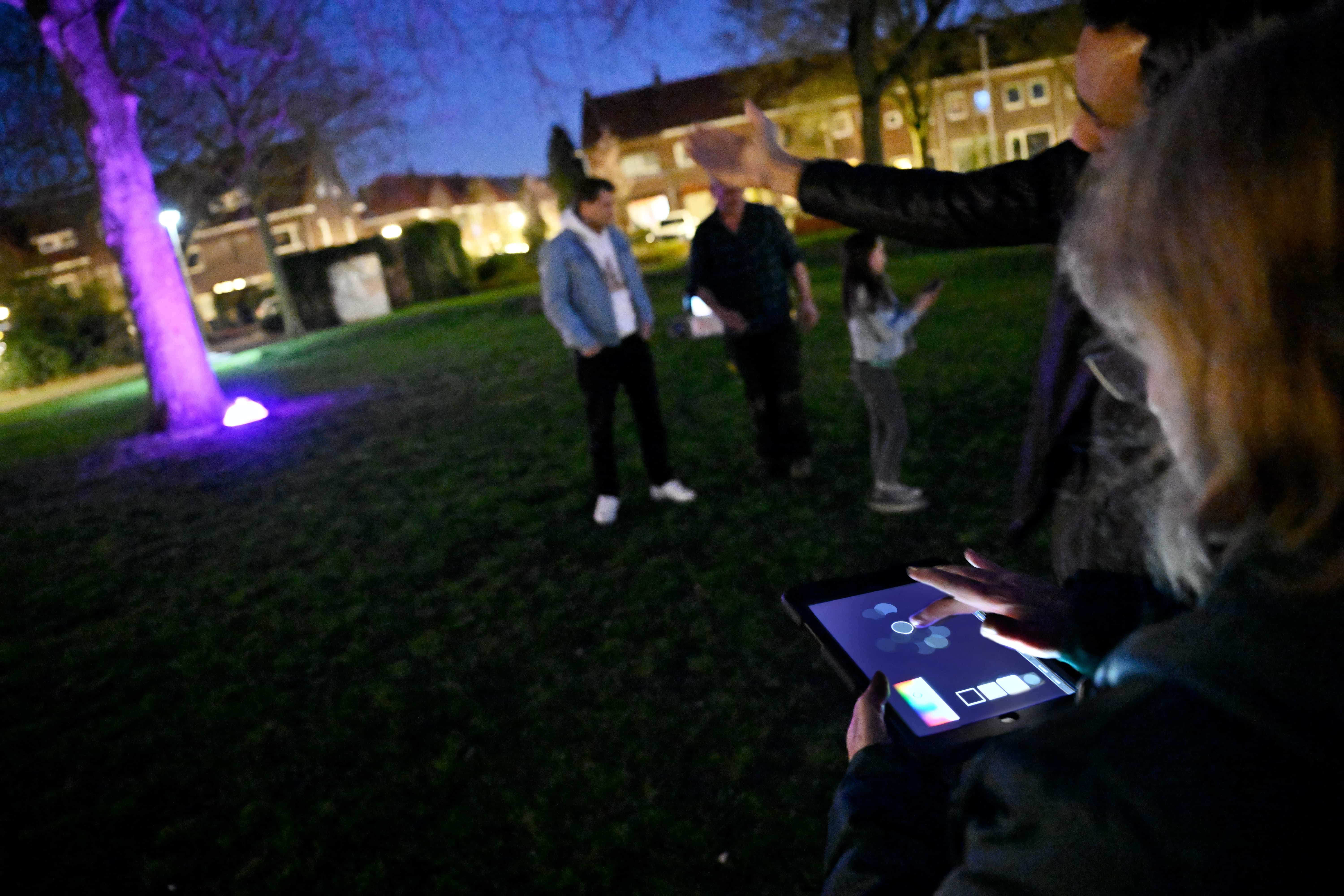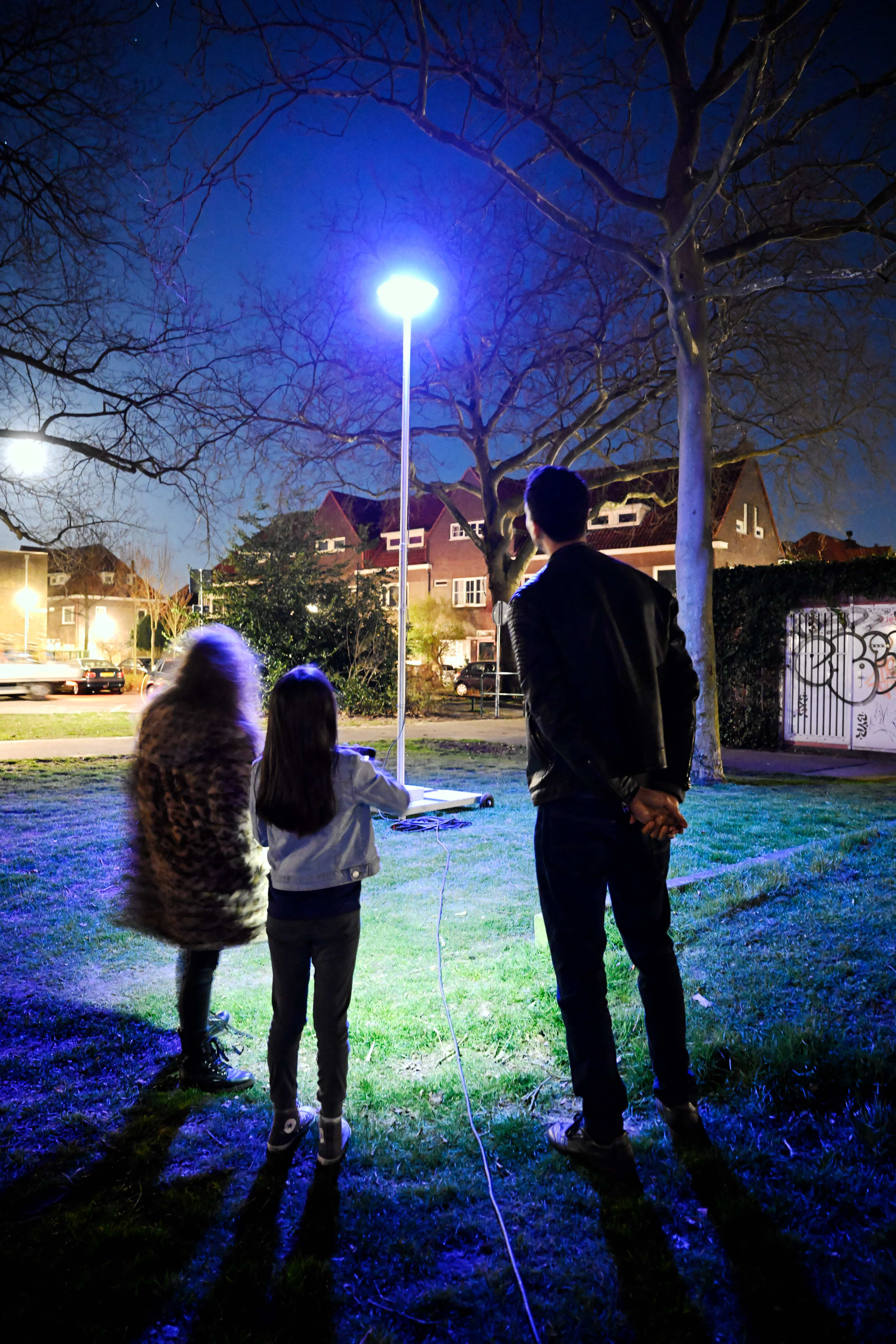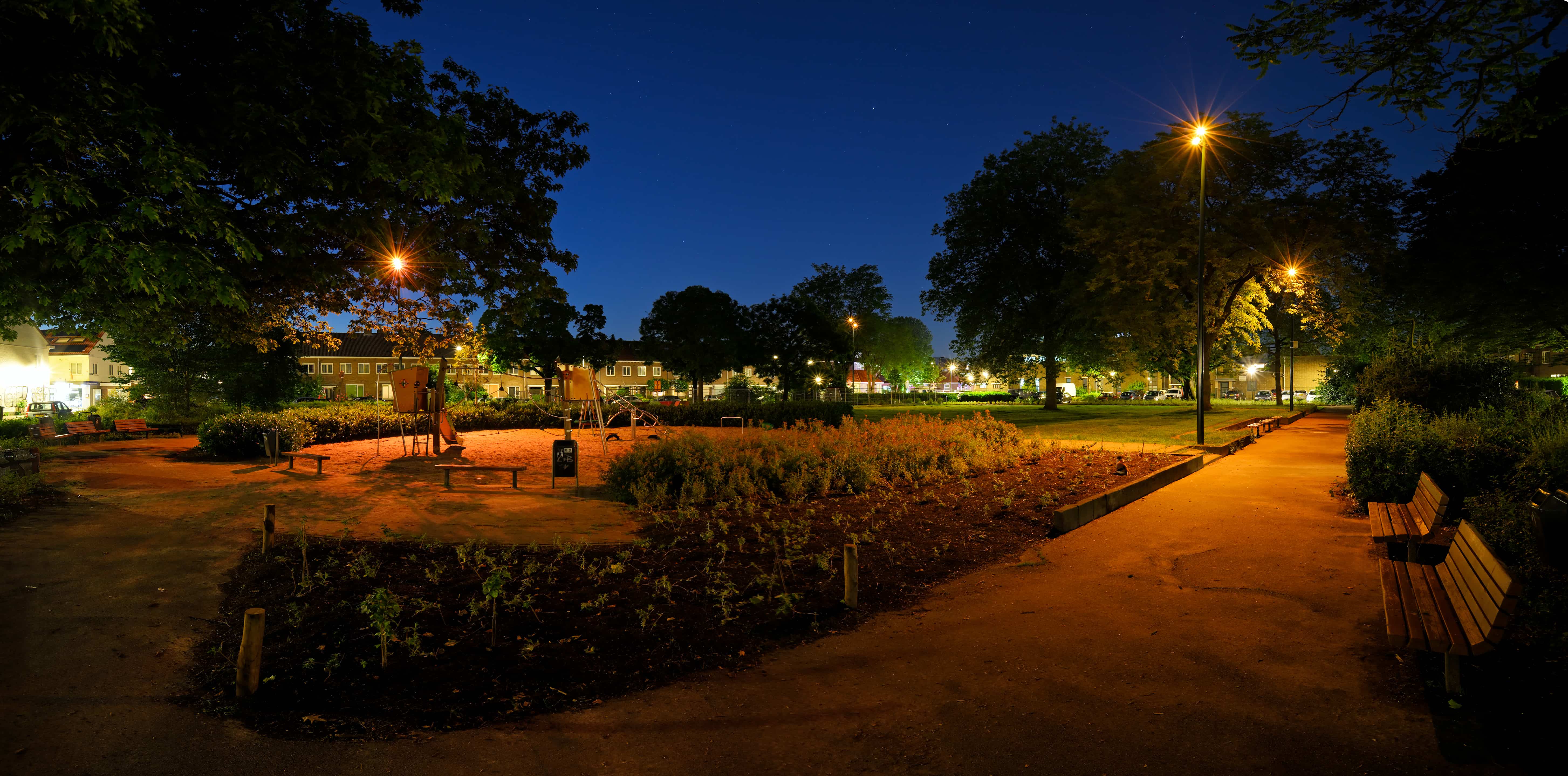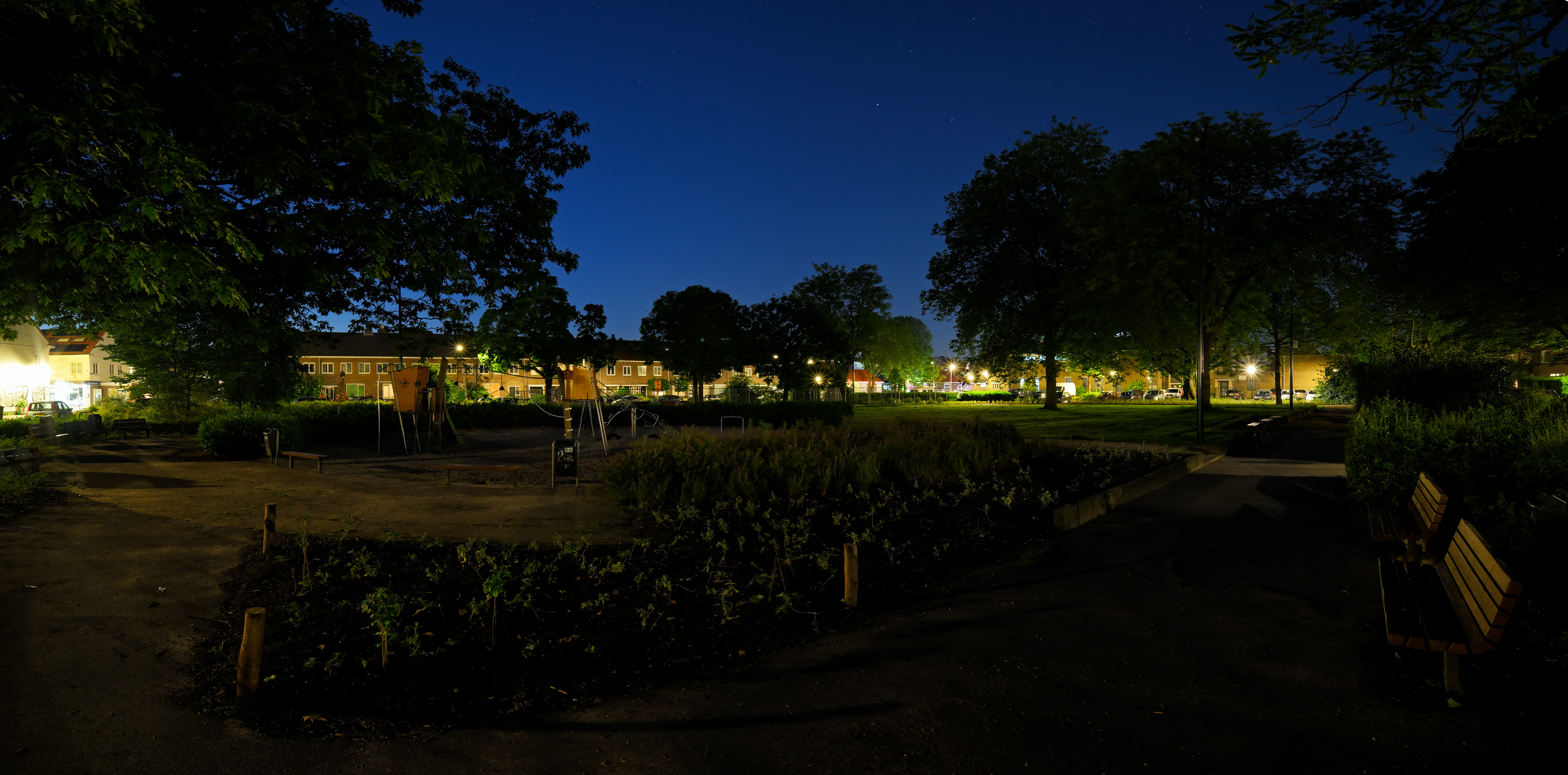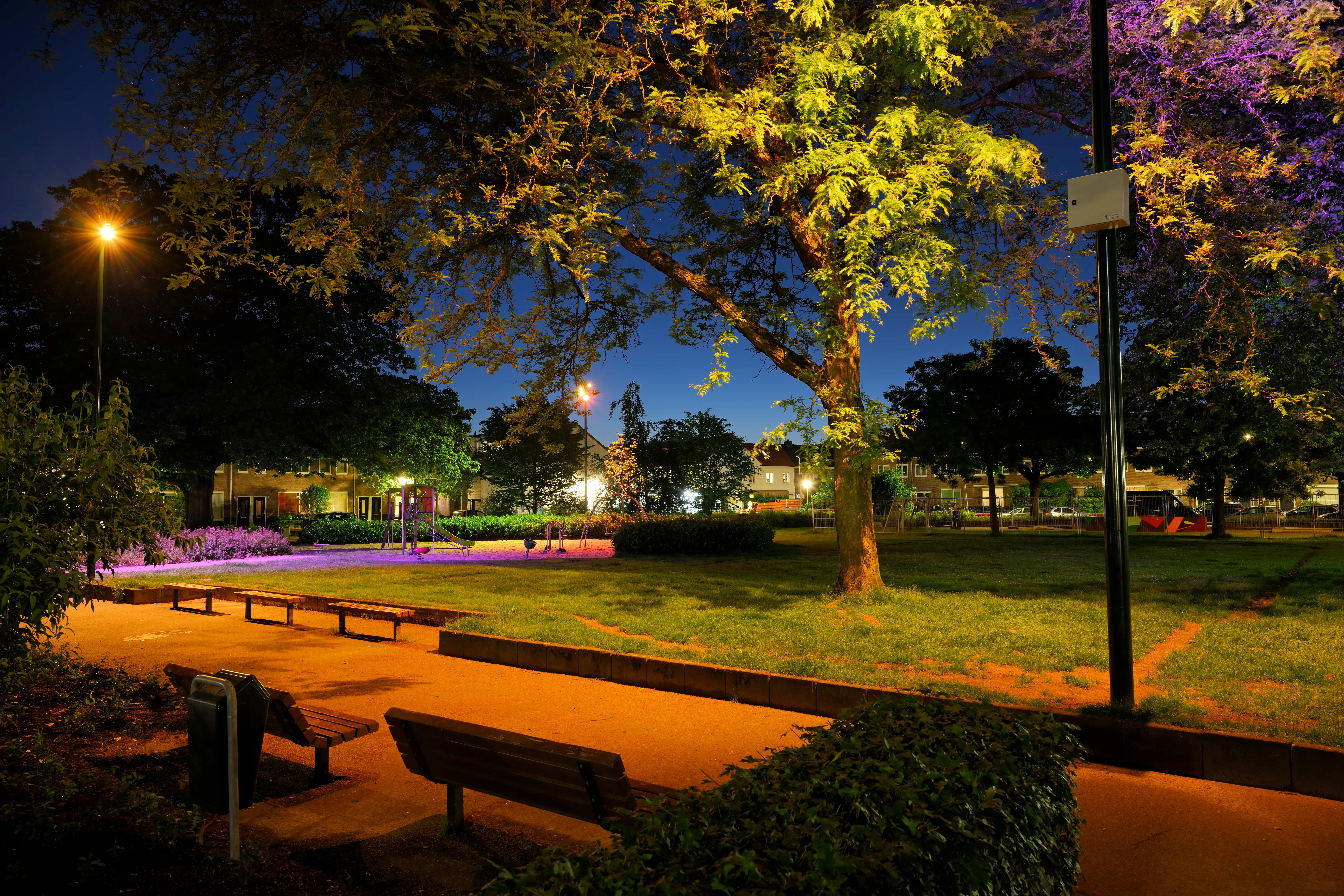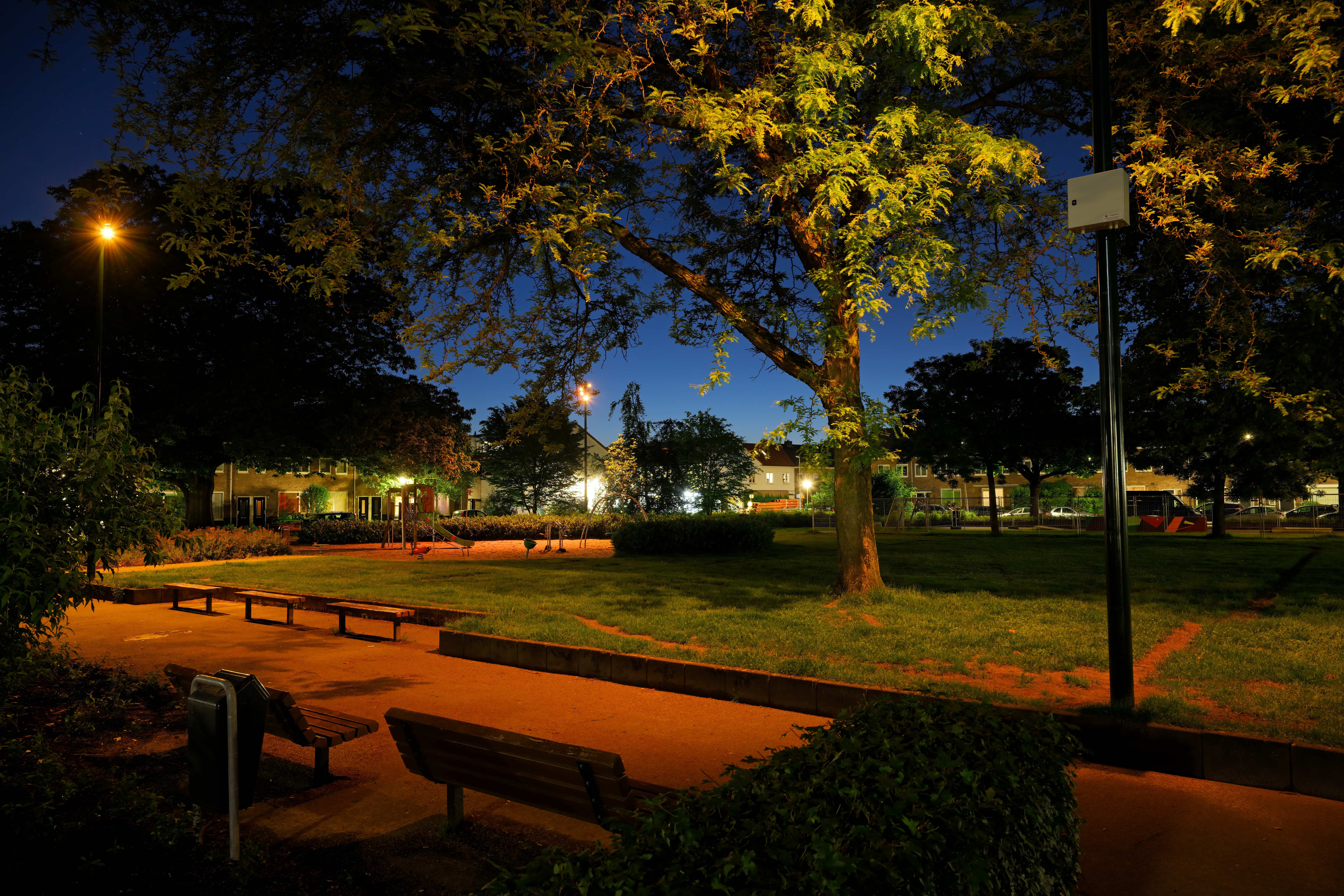Reconnecting with nature
Kerstroosplein
Kerstroosplein: People and Nature Co-Shaping Nature-Sensitive Urban Lighting
Light is essential for cities' functioning after dark, but light pollution must decrease. At the community park Kerstroosplein, we found a new balance between light for safe use and minimising ecological impact. The revolutionary participatory approach 'Light Sketching' enabled a creative conversation between residents and nature about light, through light. The resulting lighting has strikingly low levels and impact, yet is loved by residents and points to a future of light in urban green areas.
Netherlands
Local
Eindhoven
Mainly urban
It refers to a physical transformation of the built environment (hard investment)
Yes
2025-01-31
No
No
No
As a representative of an organisation
Light pollution is an urgent and growing global problem. It disrupts ecosystems and compromises populations, like insects. Yet for many urban areas, light is essential for accessibility and social functioning after dark. How to find a balance? The Kerstroosplein project offers a new approach to find such a balance for urban green areas. Residents feared using this small community park after dark, which was deemed unsafe. They asked for lighting. The city declined, not wanting to burden local ecology with light. The revolutionary Light Sketching-method resolved this stalemate.
Light Sketching enables a creative conversation involving local residents and nature, about light through experience of light. Residents gathered at the park after dark and sketched the light they would like there on a tablet. Every stroke of these ‘Light Sketches’ was directly translated into real light in the park, via custom Light Sketching luminaires. The system also reported a measure for the light's impact on local nature, based on a scientific method and input from an ecologist: nature's voice. With this input, we tweaked the Light Sketches to minimise ecological impact: How far can we dim light and still feel safe? How much can we reduce harmful blue light while keeping an appealing aesthetic?
The results were translated into a lighting design, with appealing light scenes in the evening and night without any harmful blue light. The total light output in the evening is strikingly low: ca 4200lm, less light than 2 regular streetlights produce. This even decreases at night to ca 1700lm, in the range of just one Hue-bulb (1600lm) for a 4000m2 area! And residents love it: The square is a social connector again after dark. Kerstroosplein shows the power of a creative, experiential conversation between people and nature about light. This approach can help decrease light pollution in cities across the EU. The project is done by Studio Philip Ross supported by IK UX & HetLuxLab for Eindhoven.
Light Sketching enables a creative conversation involving local residents and nature, about light through experience of light. Residents gathered at the park after dark and sketched the light they would like there on a tablet. Every stroke of these ‘Light Sketches’ was directly translated into real light in the park, via custom Light Sketching luminaires. The system also reported a measure for the light's impact on local nature, based on a scientific method and input from an ecologist: nature's voice. With this input, we tweaked the Light Sketches to minimise ecological impact: How far can we dim light and still feel safe? How much can we reduce harmful blue light while keeping an appealing aesthetic?
The results were translated into a lighting design, with appealing light scenes in the evening and night without any harmful blue light. The total light output in the evening is strikingly low: ca 4200lm, less light than 2 regular streetlights produce. This even decreases at night to ca 1700lm, in the range of just one Hue-bulb (1600lm) for a 4000m2 area! And residents love it: The square is a social connector again after dark. Kerstroosplein shows the power of a creative, experiential conversation between people and nature about light. This approach can help decrease light pollution in cities across the EU. The project is done by Studio Philip Ross supported by IK UX & HetLuxLab for Eindhoven.
Participatory design
Nature sensitive design
Minimising light pollution
Lighting Design
Ecological co-design
Minimising the impact of artificial lighting on local urban nature is a key objective. Absence of light is best for nature. But green urban areas in the middle of communities often need light to remain accessible, and to perform their social and wellbeing functions after dark. The key challenge was how to make the Kerstroosplein accessible and welcoming after sundown, while using as little light as possible and light spectra that are minimally impactful on nature. ‘Standard’ public lighting would not do: This would produce too much light and the spectrum would not be optimal. ‘Bat friendly’ (I do not support this term) red lighting would not give an acceptable atmosphere.
Light Sketching helped debunk common prejudice that more safety requires more light: Residents experienced themselves how high light levels killed the atmosphere and reduced overview by blinding effects (‘glare’). They also saw how soft and warm lighting was gentler for the eyes and improved overview through absence of glare. People also saw that they could do with far less light than normal, if it was directed on the right surfaces. And people actually liked colours that are less impactful on nature, generally colours without blue light giving a warm atmosphere. The resulting total evening light output is only ca. 4200lm, going down at night to a very low ca 1700lm. Note that a sober ‘standard’ scheme with 5 luminaires at 40m spacing around the path would already produce ca. 12.000lm! The total energy use is also small: In the evening ca. 105W and at night only ca. 55W.
Several insights can be exemplary to other projects: That people can be open to very low light levels if they can experience them in the process. And the fact that people can actually like colours that are generally less impactful for nature, can inspire other lighting design projects around urban green areas. Note that decreasing light levels is most important for decreasing impact on nature. Tuning colours comes after that.
Light Sketching helped debunk common prejudice that more safety requires more light: Residents experienced themselves how high light levels killed the atmosphere and reduced overview by blinding effects (‘glare’). They also saw how soft and warm lighting was gentler for the eyes and improved overview through absence of glare. People also saw that they could do with far less light than normal, if it was directed on the right surfaces. And people actually liked colours that are less impactful on nature, generally colours without blue light giving a warm atmosphere. The resulting total evening light output is only ca. 4200lm, going down at night to a very low ca 1700lm. Note that a sober ‘standard’ scheme with 5 luminaires at 40m spacing around the path would already produce ca. 12.000lm! The total energy use is also small: In the evening ca. 105W and at night only ca. 55W.
Several insights can be exemplary to other projects: That people can be open to very low light levels if they can experience them in the process. And the fact that people can actually like colours that are generally less impactful for nature, can inspire other lighting design projects around urban green areas. Note that decreasing light levels is most important for decreasing impact on nature. Tuning colours comes after that.
I believe in a pragmatist concept of aesthetics: Through design, we influence how people experience an environment and this can serve a purpose. In this case, the purpose was to increase the accessibility and the (social) use of the space. For this, it was important to create an environment that gives overview, is welcoming, feels safe and emphasises the elements in the environment that give it identity. Instead of focusing light on the path, like traditional outdoor lighting would do, we gave light to objects like the playground equipment, benches, the soccer field and hedges. This had two effects: 1. Lighting these vertical surfaces gives a far brighter impression than lighting horizontal surfaces with the same amount of light. This means we could visually do more with less light. 2. These objects (e.g. the playground and soccer field) also express the identity of the neighbourhood, with children of all ages and a child care centre bordering the park.
The colours used in the lighting scenes are a combination of the colours people chose in the Light Sketching sessions and the ecological tweaks. In the afternoon, the time kids play in the playground, there are some playful colour accents. In the evening, a fully ‘nature sensitive’ aesthetic takes over, with mostly warm colours without blue component. The colour schemes were widely appreciated.
The two evaluation sessions we did with the residents, in the course of 8 months, pointed out that they appreciated the atmosphere very much. Residents described the atmosphere with terms like ‘warm’, ‘cozy’ and ‘beautiful’. Their remarks included: "the square looks more neat", and "I have better overview, even from my house”. The fact that the nature sensitive lighting aesthetic, with low levels and less harmful light colours, is appreciated can serve as an example for other similar green urban areas that need light to perform their community function at minimal ecological costs.
The colours used in the lighting scenes are a combination of the colours people chose in the Light Sketching sessions and the ecological tweaks. In the afternoon, the time kids play in the playground, there are some playful colour accents. In the evening, a fully ‘nature sensitive’ aesthetic takes over, with mostly warm colours without blue component. The colour schemes were widely appreciated.
The two evaluation sessions we did with the residents, in the course of 8 months, pointed out that they appreciated the atmosphere very much. Residents described the atmosphere with terms like ‘warm’, ‘cozy’ and ‘beautiful’. Their remarks included: "the square looks more neat", and "I have better overview, even from my house”. The fact that the nature sensitive lighting aesthetic, with low levels and less harmful light colours, is appreciated can serve as an example for other similar green urban areas that need light to perform their community function at minimal ecological costs.
There are two kinds of inclusion at play:
* Inclusion in the process: The Kerstroosplein is a social housing area, with a bad image at night. People reported drug dealing and felt intimidated by unrecognisable people in the dark. Yet there is social cohesion in the neighbourhood. A key objective of the project was to involve the residents in the process. They are the specialists about the area, and they are the most important stakeholders. But normal participation methods, like questionnaires, or 'post-it design’ sessions would not work for a project like this. People can be reluctant to join such sessions, due to low affinity with such activities or low literacy. And describing lighting is very difficult, since light is about experience. With the Light Sketching approach, we managed to involve residents that may not have joined otherwise. Some came in response to invitation letters the city sent around. But many also came spontaneously. We were there multiple evenings with our Light Sketching set-up, and thanks to the attractive visual and social nature of the activity, people that walked their dog or saw it through their window just joined in. This way we reached many people who else would not have participated. Also, since they could express themselves through the intuitive tablet interface easily, we could have nuanced group discussions about light, at a level we could not have done with only words. The Light Sketching also stimulated conversation and compromises among residents about the best lighting for their community park. This experiential approach, which can also be followed using other tools, can serve as an example to other cities that aim to involve people in designing ‘their’ public space.
* Inclusion through accessibility: People who feel they cannot safely use public space at night avoid it, which makes public space de facto less accessible to them. The new lighting improves feeling of safety and thus indirectly accessibility.
* Inclusion in the process: The Kerstroosplein is a social housing area, with a bad image at night. People reported drug dealing and felt intimidated by unrecognisable people in the dark. Yet there is social cohesion in the neighbourhood. A key objective of the project was to involve the residents in the process. They are the specialists about the area, and they are the most important stakeholders. But normal participation methods, like questionnaires, or 'post-it design’ sessions would not work for a project like this. People can be reluctant to join such sessions, due to low affinity with such activities or low literacy. And describing lighting is very difficult, since light is about experience. With the Light Sketching approach, we managed to involve residents that may not have joined otherwise. Some came in response to invitation letters the city sent around. But many also came spontaneously. We were there multiple evenings with our Light Sketching set-up, and thanks to the attractive visual and social nature of the activity, people that walked their dog or saw it through their window just joined in. This way we reached many people who else would not have participated. Also, since they could express themselves through the intuitive tablet interface easily, we could have nuanced group discussions about light, at a level we could not have done with only words. The Light Sketching also stimulated conversation and compromises among residents about the best lighting for their community park. This experiential approach, which can also be followed using other tools, can serve as an example to other cities that aim to involve people in designing ‘their’ public space.
* Inclusion through accessibility: People who feel they cannot safely use public space at night avoid it, which makes public space de facto less accessible to them. The new lighting improves feeling of safety and thus indirectly accessibility.
Citizens benefitted very directly from the project, since their wish to feel safer after dark in their community park in the middle of their neighbourhood is now a reality. For the neighbourhood coordinator of the municipality, the project was beneficial as well. She was dealing with discontent residents, since they felt the municipality did not act on their complaints. She described the project as "a present for the neighbourhood". It also gave her more informal contact moments with the residents to discuss other issues on the side.
The client was the lighting department of the municipality. They were open to use the innovative Light Sketching approach to find a balance between light for safety and minimising impact on nature. The community coordinator of the municipality helped get us in touch with the local residents, and organised the announcement and information letters to the residents. The community coordinator and the lighting project officer both participated in the resident engagement activities, such as the Light Sketching sessions and the resident interviews. The value of their engagement was that residents could see that the municipality was actively involved and appreciated their feedback.
* Ecology: At the very beginning of the process, an ecologist made a scan of the area to identify the ecological attention points in the area (e.g. nesting possibilities in trees that needed to be kept dark). This influenced the parameters we put into the system, for example, which animals to use in our calculations.
Furthermore, we used a scientific method to calculate impact of light on specific animals and other ecological factors like Sky glow. This method, called 'Rapid assessment of lamp spectrum to quantify ecological effects of light at night', by Longcore et al. is developed on the cross section of lighting physics and ecology. That researcher helped implement the methodology in the Light Sketching system.
* Lighting design: The lighting design discipline translated the desired lighting qualities from the Light Sketches into a functional hardware set-up with programmed light scenes. All this ensuring that the result would support the residents in using the park, creating a pleasant welcoming atmosphere. Lighting design was also about fitting all equipment aesthetically in the environment, both during daytime and nighttime. The lighting design was supported by design firm HetLuxLab.
* Psychology: A User Experience researcher (IK UX) assisted in doing on-site location research, structuring interviews and analysing the results. These results then served as input into the lighting design.
The process greatly depended on this interaction between the disciplines ecology, physics, psychology and lighting design.
Furthermore, we used a scientific method to calculate impact of light on specific animals and other ecological factors like Sky glow. This method, called 'Rapid assessment of lamp spectrum to quantify ecological effects of light at night', by Longcore et al. is developed on the cross section of lighting physics and ecology. That researcher helped implement the methodology in the Light Sketching system.
* Lighting design: The lighting design discipline translated the desired lighting qualities from the Light Sketches into a functional hardware set-up with programmed light scenes. All this ensuring that the result would support the residents in using the park, creating a pleasant welcoming atmosphere. Lighting design was also about fitting all equipment aesthetically in the environment, both during daytime and nighttime. The lighting design was supported by design firm HetLuxLab.
* Psychology: A User Experience researcher (IK UX) assisted in doing on-site location research, structuring interviews and analysing the results. These results then served as input into the lighting design.
The process greatly depended on this interaction between the disciplines ecology, physics, psychology and lighting design.
The biggest innovation in this project is the Light Sketching method. The Light Sketching system is unique in the world. The quality that makes it so innovative is that people can intuitively sketch complex (coloured) light patterns on a tablet, and that these light patterns appear real-time in their real environment, rendered by the advanced LED luminaires of the system. This makes a creative conversation about light possible, via light. A conversation you can normally not have, because it is hard to find words for the nuances of light, and it is especially hard to imagine how your daily environment would change with it. Through making light directly experienceable, people can respond to it, understand its nuances and be creative with it.
The second innovative feature that makes it unique is the real-time calculation of impact of the light spectra in the light sketches on specific animals, such as bats, mice, or other measures like Sky glow. This is based on the scientific method called 'Rapid assessment of lamp spectrum to quantify ecological effects of light at night', by researcher T. Longcore et al.
A third innovative aspect is the use of RGBW (Red Green Blue and White) LED lighting as general lighting in public space. Using colour happens more often in illuminating special objects or light art in public space, but it is seldom used for general illumination. We used it to get the freedom to tune the spectrum of the light to minimise impact on nature.
The second innovative feature that makes it unique is the real-time calculation of impact of the light spectra in the light sketches on specific animals, such as bats, mice, or other measures like Sky glow. This is based on the scientific method called 'Rapid assessment of lamp spectrum to quantify ecological effects of light at night', by researcher T. Longcore et al.
A third innovative aspect is the use of RGBW (Red Green Blue and White) LED lighting as general lighting in public space. Using colour happens more often in illuminating special objects or light art in public space, but it is seldom used for general illumination. We used it to get the freedom to tune the spectrum of the light to minimise impact on nature.
The methodology can be labelled as a combination of Participatory Design and Eco-Inclusive Design. I elaborate this based on the 7 key aspects of Participatory Design (as formulated by interaction-design.org).
*Inclusion of a diverse range of participants: We involved residents and non-residents that frequently use the park, with different ages and gender. We also involved city officials, like the neighbourhood coordinator and public lighting officer. Importantly, nature also had a voice in the creative process through the system.
* Involve collaborative activities where participants can contribute their knowledge, insights, and ideas: The main collaborative activities were the Light Sketching sessions, that enabled the residents to create, experience and discuss the lighting they desired, live in their own neighbourhood.
* Empower users and stakeholders to actively influence design decisions: The residents' own Light Sketches formed a main input for the final lighting design, combined with nature's input. We evaluated the final results with the residents twice and made adjustments on their request.
* The design process is iterative, with continuous feedback and refinement: The project roughly has three iterations: First the Light Sketches, then the lighting design, and then the finetuning of the lighting scenes through evaluations with residents.
* Listen to the participants to understand the context of use: Before the Light Sketching sessions, we observed the park on 4 different occasions, during the day and the night, and interviewed people there, to get more contextual understanding. The Light Sketching sessions and interviews after realisation also brought insights about the context of use.
*Allow users to advocate for themselves throughout the design process: We made sure we were approachable for this. Residents could advocate for themselves in person on-site during the sessions, but also via other channels, like e-mail, after the sessions.
*Inclusion of a diverse range of participants: We involved residents and non-residents that frequently use the park, with different ages and gender. We also involved city officials, like the neighbourhood coordinator and public lighting officer. Importantly, nature also had a voice in the creative process through the system.
* Involve collaborative activities where participants can contribute their knowledge, insights, and ideas: The main collaborative activities were the Light Sketching sessions, that enabled the residents to create, experience and discuss the lighting they desired, live in their own neighbourhood.
* Empower users and stakeholders to actively influence design decisions: The residents' own Light Sketches formed a main input for the final lighting design, combined with nature's input. We evaluated the final results with the residents twice and made adjustments on their request.
* The design process is iterative, with continuous feedback and refinement: The project roughly has three iterations: First the Light Sketches, then the lighting design, and then the finetuning of the lighting scenes through evaluations with residents.
* Listen to the participants to understand the context of use: Before the Light Sketching sessions, we observed the park on 4 different occasions, during the day and the night, and interviewed people there, to get more contextual understanding. The Light Sketching sessions and interviews after realisation also brought insights about the context of use.
*Allow users to advocate for themselves throughout the design process: We made sure we were approachable for this. Residents could advocate for themselves in person on-site during the sessions, but also via other channels, like e-mail, after the sessions.
The project can well be replicated to other places. The Light Sketching approach has already been applied to four other city locations. But the experiential approach can also be done with other kinds of tools, that give experience of light a role in the creative process. The approach is best suited for situations that present a dilemma between human needs and minimising ecological impact.
The luminaires and control equipment we used in the final set-up are all off-the-shelve and available on the market, so they can be applied in other locations easily.
Some of the insights from this approach can also be useful in other contexts. For example, the acceptance of lower light levels we found can inspire designers to explore doing more with less light in green urban areas. Likewise, the appreciation of very warm colours for general public lighting, with spectra that are less impactful on nature than standard public lighting colours, opens up a whole new approach to public lighting that is more nature sensitive.
These points come with the remark that no two locations are the same in terms of people and nature. So copy-pasting without design expertise is never advised. Another important remark is that this method is specifically directed at urban green areas, that need light to function for the local community after dark. Green areas outside the city without the social function, can best be left totally unlit, since nature in general fares best with no light at all.
The luminaires and control equipment we used in the final set-up are all off-the-shelve and available on the market, so they can be applied in other locations easily.
Some of the insights from this approach can also be useful in other contexts. For example, the acceptance of lower light levels we found can inspire designers to explore doing more with less light in green urban areas. Likewise, the appreciation of very warm colours for general public lighting, with spectra that are less impactful on nature than standard public lighting colours, opens up a whole new approach to public lighting that is more nature sensitive.
These points come with the remark that no two locations are the same in terms of people and nature. So copy-pasting without design expertise is never advised. Another important remark is that this method is specifically directed at urban green areas, that need light to function for the local community after dark. Green areas outside the city without the social function, can best be left totally unlit, since nature in general fares best with no light at all.
The main global challenge the project addresses is Light Pollution: a rapidly growing worldwide challenge due to urbanisation and decreasing costs of light. Light pollution “is the human-made alteration of outdoor light levels from those occurring naturally” (DarkSky Association). It disturbs wildlife and disrupts ecosystems. Insect populations, already under threat in the EU, decline further due to large-scale fatal attraction by light. 99 Percent of the EU population cannot see the natural night sky anymore. Light Pollution also has negative effects on human health, for example through light trespassing into bedrooms. Light pollution inherently entails waste of energy and CO2 through unnecessary light. The EU released a Future Brief about light pollution in November 2023, elaborating on this challenge.
Cities are becoming more densely populated. At the same time cities want to offer more green, to support health and wellbeing of their residents. The need to find a balance between light for people and minimal impact on urban nature will become ever more frequent. This means there is a growing need for a design process that is equipped for this. Black-and-white thinking does not lead to a solution: The one extreme wants no light at all in urban green areas, or only red light because that would be the least burdensome colour for nature. But these options are not acceptable to most people. The other extreme wants as much light as possible, based on the unfounded idea that more light always brings more safety. But that is unnecessarily harmful to nature and light polluting. Sticking to the extremes excludes any solution, so we have to look for a balance between seemingly mutually exclusive interests. The project shows that such a balance can be found: A light environment that increases feelings of safety and creates a pleasant atmosphere, with very low light levels and light colours that are tailored to reduce ecological impact.
Cities are becoming more densely populated. At the same time cities want to offer more green, to support health and wellbeing of their residents. The need to find a balance between light for people and minimal impact on urban nature will become ever more frequent. This means there is a growing need for a design process that is equipped for this. Black-and-white thinking does not lead to a solution: The one extreme wants no light at all in urban green areas, or only red light because that would be the least burdensome colour for nature. But these options are not acceptable to most people. The other extreme wants as much light as possible, based on the unfounded idea that more light always brings more safety. But that is unnecessarily harmful to nature and light polluting. Sticking to the extremes excludes any solution, so we have to look for a balance between seemingly mutually exclusive interests. The project shows that such a balance can be found: A light environment that increases feelings of safety and creates a pleasant atmosphere, with very low light levels and light colours that are tailored to reduce ecological impact.
This project has made the local community reconnect with the green area in their neighbourhood after dark. Local nature was given a co-shaping role in designing light that balances the needs of the local people with minimising ecological impact. This input from nature does not feel like a compromise, but is rather a quality of the result.
The resulting lighting allows residents to enjoy the community park again after dark, have a healthy walk and meet each other. The light enhances the unique identity of the park and creates a welcoming, safe and warm atmosphere. The creative input of the residents themselves in the lighting makes it theirs.
All this is achieved with extremely low light levels, factors lower than 'standard' public lighting, and with light spectra that are less impactful for nature than normal. As such, the design can help debunk the improductive idea that more safety always requires more light, and it opens up an inspiring design space of using less light with nature-sensitive colours. This approach contributes to the challenge of minimising light pollution in ever growing cities. Let’s give the final word to one of the residents through this quotes:
"I am personally very happy with it. First of all, I think it is super important that the animals and insects in the park have been taken into account and colours have been used that disturb nature the least. Secondly, I like a warm colour lighting so I really like this warm light that gives the square an orange glow. And thirdly, I am very happy that everything is now better lit because of the feeling of safety."
The resulting lighting allows residents to enjoy the community park again after dark, have a healthy walk and meet each other. The light enhances the unique identity of the park and creates a welcoming, safe and warm atmosphere. The creative input of the residents themselves in the lighting makes it theirs.
All this is achieved with extremely low light levels, factors lower than 'standard' public lighting, and with light spectra that are less impactful for nature than normal. As such, the design can help debunk the improductive idea that more safety always requires more light, and it opens up an inspiring design space of using less light with nature-sensitive colours. This approach contributes to the challenge of minimising light pollution in ever growing cities. Let’s give the final word to one of the residents through this quotes:
"I am personally very happy with it. First of all, I think it is super important that the animals and insects in the park have been taken into account and colours have been used that disturb nature the least. Secondly, I like a warm colour lighting so I really like this warm light that gives the square an orange glow. And thirdly, I am very happy that everything is now better lit because of the feeling of safety."

